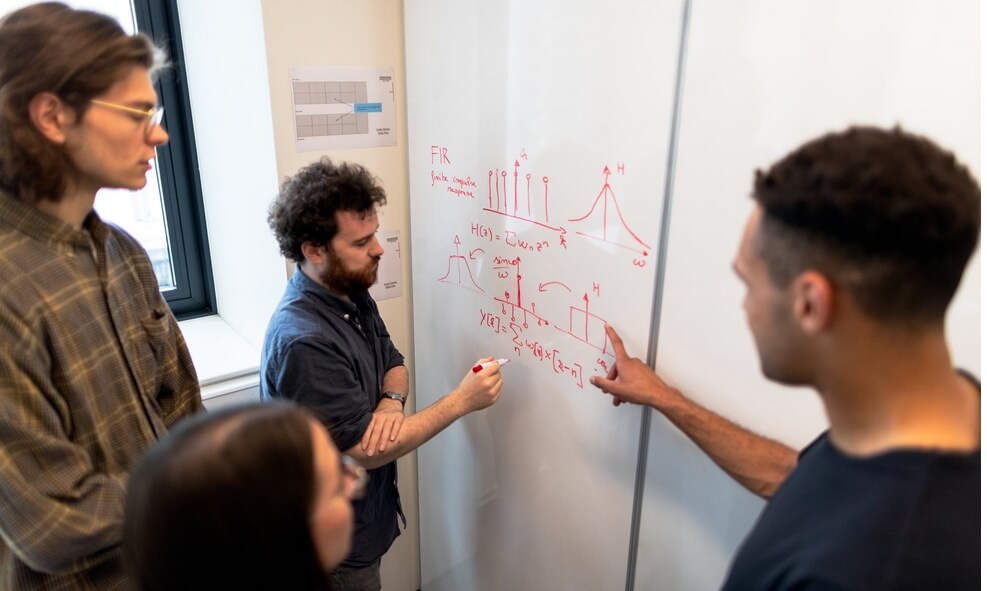Data Science Seminar Abstract
Data science aims to find valuable insights from large sets of information. Data science is a fast-growing field that’s getting more attention than ever. This article will look at data science from a different angle, how it’s used in business and industry, and what you’ll need to get started as a data scientist.

Here are key aspects and processes associated with data science:
- Data Collection: Data science starts with the collection of relevant data from various sources, which can include databases, websites, APIs, sensors, social media, or any other available data sources. This data can be structured (organized in a predefined format) or unstructured (not in a predefined format).
- Data Cleaning and Preprocessing: Raw data often contains errors, inconsistencies, missing values, or irrelevant information. Data cleaning and preprocessing involve techniques to address these issues, including removing duplicates, handling missing data, standardizing formats, and transforming the data into a suitable format for analysis.
- Exploratory Data Analysis (EDA): EDA involves exploring and understanding the data through statistical techniques, visualization, and summary statistics. It helps identify patterns, relationships, anomalies, and other insights that can guide further analysis.
- Statistical Analysis and Modeling: Data science employs statistical methods and mathematical models to analyze data and uncover patterns or relationships. This can involve regression, hypothesis testing, clustering, classification, time series analysis, and machine learning algorithms.
- Machine Learning: Machine learning is a subset of data science that focuses on developing algorithms and models that can learn from data and make predictions or decisions without being explicitly programmed. It involves training models on historical data to make predictions or classify new data based on learned patterns.
- Data Visualization: Data visualization is an essential component of data science, as it helps communicate insights and findings effectively. Visual representations such as charts, graphs, and interactive dashboards enable data scientists to convey complex information more understandably and insightfully.
- Feature Engineering: Feature engineering involves selecting, transforming, and creating relevant features from raw data to improve the performance of machine learning models. It includes techniques such as dimensionality reduction, feature scaling, feature extraction, and feature selection.
- Model Evaluation and Deployment: Data scientists evaluate the performance of their models using appropriate metrics and validation techniques. They fine-tune the models, test their generalizability, and ensure they meet the desired objectives. Once a satisfactory model is achieved, it can be used in real-world applications.
- Iterative Process and Continuous Learning: Data science is an iterative process where models and analyses are refined based on feedback and new data. It involves continuous learning, adaptation, and improvement as new insights are gained and new challenges are encountered.
Related: Seminar Topics on Artificial Intelligence Technology
The field of data science
Data science draws from computer science, information retrieval, mathematics, statistics, and others. Its practitioners are often trained as software engineers or database administrators but also need a strong understanding of statistics and machine learning. They may have backgrounds in physics or biology; some even have an art degree!
Data scientist is an umbrella term that encompasses various roles within organizations (e.g., business analysts) that use data to improve their performance. A typical data scientist will typically:
- Analyze large volumes of raw data using statistical techniques such as regression
- Design algorithms for analyzing those same raw datasets
- Come up with hypotheses about how certain variables affect other ones based on these. analyses; this is known as predictive modelling.
The goal of Data Science.
The goal of data science is to find valuable insights from data. This can be done by following these steps:
- Finding patterns in your data. For example, if you have a list of customers who bought a particular product and then dropped out of repurchasing it, you could use this information to recommend what kind of advertising campaign would most likely get them back on board again with that product.
- Making predictions based on the patterns found in your data (or using models). For example, if all customers who have bought one particular type of product tend not to purchase any others very often—and those who do tend to buy more than average—you might predict that they’ll start buying other types as well once they learn about them (by reading blogs or watching videos).
Data mining techniques are used to discover patterns in large datasets.
Data mining is the process of finding patterns in large datasets. It involves data analysis techniques to discover new insights and validate existing knowledge.
Data mining can uncover new trends, associations, and correlations within a large dataset. It can also confirm what you know about your business or industry by showing whether certain factors are associated with other variables (for example, sales volumes).
Significance of data science in business, government, and industry.
Data science is a growing field that can significantly impact business, government and industry. Companies use data science to improve their operations and make better decisions. Government agencies use data science to improve education, health care policies and more. Medical researchers use data science as part of their research process to find new ways to treat diseases or prevent them from happening altogether.
The skills you need vary depending on the job you’re aiming for.
There are many different types of data scientists. Some work in corporate environments, others with academic institutions. The skills required to be a data scientist vary depending on the job you’re aiming for and how you plan to use your statistics and machine learning knowledge.
For example, suppose your goal is to analyze customer behaviour around an app or website and recommend what features would be most valuable for users. In that case, this type of work will require different skills than hiring an analyst at Google (who would be looking at large amounts of data).
Importance of Data Science
Data Science has become an essential tool in various industries. It plays a significant role in decision-making and helps businesses gain a competitive edge. With the help of Data Science, companies can identify patterns and trends in data, which can be used to optimize their operations and improve their products and services. Data Science also plays a critical role in predicting future trends, which is essential for businesses to stay ahead of the competition.
Future of Data science.
Data science is a promising career field because it’s both challenging and in demand, but there is no one standard path to becoming a data scientist. Data science is a growing field, and there is no traditional path to becoming a data scientist. Being passionate about the subject and willing to learn new skills would be best. It would be best if you also worked in teams, communicated well with others, and had technical skills above average for your age group.
Some people enter this career field after completing their undergraduate degrees; others take more time before landing jobs—especially if they’ve chosen an engineering major or another technical discipline instead of business or computer science (which require less training).
Many data scientists have graduate degrees or higher degrees.
A master’s degree is required for most data science jobs, and a PhD is not always needed but can be helpful. Some data scientists have backgrounds in math or statistics, while others come from computer science or engineering backgrounds.
You should know how to use a programming language like Python or R, as well as how to use SQL to manipulate databases. SQL is a language for querying relational databases used to interact with data stored in these databases. It’s not just for databases; it’s also used in data warehouses (which store large amounts of structured and unstructured information), business intelligence and analytics (which provide valuable insight into your company’s operations), search engines like Google or Bing (for indexing content), integrated search applications such as DuckDuckGo (for finding text on the web) and many more applications!

Data Analytics.
You’ll learn how to analyze data sets and create compelling visualizations with software such as Tableau or Qlikview. You’ll also need to know SQL, the programming language that allows you to manipulate databases. Some examples of this include:
- Creating interactive dashboards with Tableau
- Diving into a deep-dive presentation with Qlikview
Data science handles complex sets of information.
Data science is an exciting and growing field that finds insights from complex sets of information. The ability to interpret and visualize large amounts of data is critical for many industries, including business, health care, transportation and education. Data scientists are not just programmers or computer scientists. They have a deeper understanding of analysing trends in large data sets than most other engineers or analysts do. Data scientists often have master’s degrees in statistics or mathematics; some also hold doctorate degrees.
Data Science has become an essential field in today’s world. It has revolutionized the way businesses operate and has helped them gain a competitive edge. The techniques used in Data Science have allowed us to extract insights from vast amounts of data, which would have been impossible otherwise. As the amount of data being generated continues to grow, the importance of Data Science will only increase.
Techniques Used in Data Science
Data Science involves various techniques such as data mining, machine learning, and data visualization. Data mining consists of extracting insights from data using statistical algorithms. Machine learning involves training models on data to make predictions or decisions. Data visualization consists of presenting data in a visual format, such as charts and graphs, to make it easier to understand.

Conclusion
It’s hard to imagine a world without data scientists. They help companies stay ahead of the competition by identifying trends, solving problems and helping people make better decisions. Data science is a field that is snowballing, so if you want to work with data in your career or learn more about it, this article should give you an idea of what kind of skills will be required at different stages in your life.
References
- https://www.collegelib.com/data-science/
- https://en.wikipedia.org/wiki/Data_science
- https://www.oracle.com/in/what-is-data-science/
Collegelib.com prepared and published this curated seminar report on Data Science for Engineering degree students’ seminar topic preparation. In addition to this information, you should research before shortlisting your topic. Please include the following Reference: Collegelib.com and link back to Collegelib in your work.
Related Articles for further reference:
- 10 Topics from Data Mining, Data Analytics, Big data, Predictive Analytics
- Data Mining – FULL Seminar Report
- Database Security issues and challenges Seminar Report
- Data mining system
- Data Analytics
This article was initially published on Collegelib in 2023.